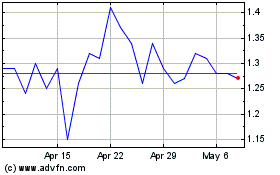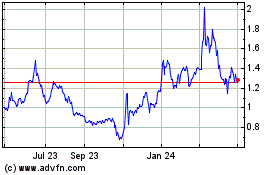Clearside Biomedical, Inc. (Nasdaq: CLSD), a biopharmaceutical
company revolutionizing the delivery of therapies to the back of
the eye through the suprachoroidal space (SCS®), announced today
that key data from the Phase 1/2a OASIS clinical trial were
presented at The Retina Society 56th Annual Scientific Meeting. The
results of the trial demonstrate the key benefits of Clearside’s
patented suprachoroidal delivery platform and its lead drug
candidate, CLS-AX (axitinib injectable suspension) being developed
for the treatment of neovascular age-related macular degeneration
(wet AMD or nAMD).
The presentation, entitled, “Safety and
Tolerability of CLS-AX via Suprachoroidal Injection in nAMD
Patients with Persistent Activity Following Anti-VEGF Therapy” was
delivered by David M. Brown, MD, Retina Consultants of Texas.
CLS-AX is a proprietary suspension formulation of the tyrosine
kinase inhibitor (TKI) axitinib that provides high potency pan-VEGF
inhibition delivered via Clearside’s proprietary SCS
Microinjector®. Based on the data from OASIS, CLS-AX is currently
being investigated in a Phase 2b clinical trial entitled
ODYSSEY.
“We are looking to replicate the excellent
safety profile, stable vision, and reduced frequency of injections
we observed in OASIS and the Extension Study through 6 months in
our ODYSSEY Phase 2b clinical trial that is actively enrolling
participants in the U.S.,” said, George Lasezkay, Pharm.D., J.D.,
President and Chief Executive Officer. “Our trial is enrolling as
planned and we expect data from ODYSSEY in the third quarter of
2024. We continue to believe that our SCS Microinjector is a
best-in-class delivery method for retinal diseases as it provides a
targeted treatment approach with a reliable, in-office,
non-surgical, non-implant delivery mechanism.”
Dr. Brown’s presentation summarized the
promising data from Clearside’s 3-month Phase 1/2a OASIS clinical
trial and Extension Study through 6 months. Axitinib was described
as a highly potent, pan-VEGF TKI to treat wet AMD which has shown
10x more potency than other TKS in preclinical studies. The
advantages of suprachoroidal delivery directly targeting the site
of disease at the back of the eye were featured through multiple
preclinical studies comparing equivalent doses of axitinib
injected suprachoroidally versus intravitreally.
In the OASIS and Extension Study, participants
with wet AMD who were sub-responders with active disease at
screening were followed for up to 6 months after CLS-AX treatment.
This patient population is important because enrolling difficult to
treat anti-VEGF sub-responders allowed observation of possible
signs of biologic effect while minimizing false signals. The
studies demonstrated an excellent safety profile at all doses and
timepoints with no serious adverse events (SAEs), no dose limiting
toxicities, and no adverse events (AEs) from inflammation. In
addition, signs of biologic effect with stable mean best corrected
visual acuity (BCVA) and stable mean central subfield thickness
(CST) to the 6-month timepoint were observed. Importantly, CLS-AX
exhibited early signs of durability and reduction in treatment
burden with a 77-85% reduction in injection frequency at higher
doses in cohorts 3 and 4.
Clearside’s suprachoroidal delivery platform was
also featured in a presentation by Dr. Rahul Khurana entitled,
“Suprachoroidal Delivery of RGX-314 Gene Therapy for Neovascular
AMD and Diabetic Retinopathy: Update on the AAVIATE and ALTITUDE
Phase II Studies.”
About the OASIS Phase 1/2a Clinical
Trial
OASIS was an open-label, single dose-escalation
Phase 1/2a trial in wet AMD participants to assess the safety and
tolerability of a single dose of CLS-AX administered by
suprachoroidal injection via Clearside’s SCS Microinjector®.
Eligible participants were those who demonstrated stable
visual acuity following two or more previous injections with an
intravitreal anti-VEGF agent. All enrolled participants underwent
diagnostic imaging on screening, followed by masked reading center
confirmation of persistent active disease.
OASIS was a 3-month trial, followed by a 3-month
Extension Study. The trial included four cohorts at the following
doses: Cohort 1 at 0.03 mg; Cohort 2 at 0.1 mg; Cohort 3 at 0.5 mg;
Cohort 4 at 1.0 mg. Participants from Cohorts 2, 3 and 4 who rolled
over into the Extension Study were followed for a total of 6 months
after a single dose of CLS-AX. Participants enrolled in OASIS were
heavily anti-VEGF treatment experienced with active disease at
screening, which was confirmed by an independent reading
center.
Safety and Tolerability Results in All Cohorts
in OASIS (n=27) and Extension Study (n=14):
- No serious adverse events (SAEs),
no treatment emergent adverse events (TEAEs) related to study
treatment, and no dose limiting toxicities.
- No adverse events related to
inflammation, vasculitis or vascular occlusion.
- No vitreous “floaters” or
dispersion of CLS-AX into the vitreous.
- No retinal detachments,
endophthalmitis, or adverse events related to intraocular
pressure.
Durability shown in Extension Study through 6
months in Cohorts 3 & 4 at the higher doses (n=12):
- 77% - 85% reduction in treatment burden was observed compared
to the average monthly injections in the six months before CLS-AX
administration.
- Participants not requiring additional therapy:
- ≥ 3 Months: 11/12 (92%)
- ≥ 4 Months: 10/12 (83%)
- ≥ 6 Months: 8/12 (67%)
- > 6 Months: 6/12 (50%)
Biologic Effect in Extension Study through 6
months in Cohorts 3 & 4 (n=12):
- CLS-AX showed signs of biologic
effect with stable mean BCVA and stable mean CST to the 6-month
timepoint.
- On Optical Coherence Tomography (OCT) images, anatomical signs
of TKI biologic effect were observed in anti-VEGF treatment
experienced sub-responders.
About the ODYSSEY Phase 2b Clinical
Trial
ODYSSEY is a randomized, double-masked,
parallel-group, active-controlled, multi-center, Phase 2b clinical
trial in participants with wet AMD. A total of 60 participants are
expected to be treated for 36 weeks and will be randomized to
either CLS-AX (1 mg) or aflibercept (2 mg) with a 2:1 randomization
schedule (40 participants in CLS-AX arm and 20 participants in
aflibercept arm). CLS-AX will be administered by suprachoroidal
injection via Clearside’s SCS Microinjector, and aflibercept will
be administered via intravitreal injection. Eligible participants
will be treatment-experienced and will undergo diagnostic imaging
at their screening visit followed by masked reading center
confirmation of persistent active disease. The primary outcome
measure is the mean change from baseline in best corrected visual
acuity. Secondary outcome measures include other changes from
baseline in visual function and ocular anatomy, the need for
supplemental treatment, and treatment burden as measured by total
injections over trial duration. Additional information about the
Phase 2b trial can be found on clinicaltrials.gov
(NCT05891548).
About CLS-AX (axitinib injectable
suspension)
CLS-AX (axitinib injectable suspension) is a
proprietary suspension of axitinib for suprachoroidal injection.
Axitinib is a tyrosine kinase inhibitor (TKI), currently approved
as an oral tablet formulation to treat advanced renal cell
carcinoma, that achieves pan-VEGF blockade, directly inhibiting
VEGF receptors-1, -2, and -3 with high potency and specificity.
Clearside believes this broad VEGF blockade may have efficacy
advantages over existing retinal therapies by acting at a different
level of the angiogenesis cascade and may benefit patients who
sub-optimally respond to current, more narrowly focused anti-VEGF
therapies. Suprachoroidal injection of this proprietary suspension
of axitinib has demonstrated meaningful potential in preclinical
studies in multiple species and in a Phase 1/2a wet AMD clinical
trial in which CLS-AX was well tolerated and demonstrated an
excellent safety profile. With suprachoroidal administration of
axitinib, there is the potential to achieve prolonged duration and
targeted delivery to affected tissue layers while limiting drug
exposure to the front of the eye. Clearside is developing CLS-AX as
a long-acting therapy for the treatment of retinal diseases.
About Age-Related Macular Degeneration
(AMD)
Age-related macular degeneration causes a
progressive loss of central vision and is the most common cause of
legal blindness in individuals over age 55. Neovascular AMD (Wet
AMD) is generally caused by abnormal blood vessels that leak fluid
or blood into the macula, the part of the retina responsible for
central vision, and accounts for the majority of vision loss in
patients with this disorder. In the U.S., approximately 11 million
patients are living with AMD1, and about 10% have the wet form2.
Current treatments require life-long, frequent injections to
maintain efficacy. This treatment regimen tends to cause a
treatment burden for patients resulting in reduced compliance and
under-treatment leading to potentially limited outcomes. In the
U.S., the total economic impact of late-stage AMD is estimated to
be approximately $49 billion, with the majority of costs attributed
to lower productivity related to job loss or job reduction due to
the condition3.
Sources1 Pennington, Katie L and DeAngelis,
Margaret M, Eye and Vision, Epidemiology of age-related macular
degeneration (AMD): associations with cardiovascular disease
phenotypes and lipid factors, Dec 22, 2016.2 Prall, F Ryan and
Ciulla, Thomas A, Medscape: Exudative (Wet) Age-Related Macular
Degeneration (AMD), June 16, 2022.3 Retina International, The
Socio-economic Impact of Age-related Macular Degeneration (AMD) in
Bulgaria, Germany, and USA, Oct 12, 2022.
About Clearside Biomedical,
Inc.
Clearside Biomedical, Inc. is a
biopharmaceutical company revolutionizing the delivery of therapies
to the back of the eye through the suprachoroidal space (SCS®).
Clearside’s SCS injection platform, utilizing the Company’s
patented SCS Microinjector®, enables an in-office, repeatable,
non-surgical procedure for the targeted and compartmentalized
delivery of a wide variety of therapies to the macula, retina, or
choroid to potentially preserve and improve vision in patients with
sight-threatening eye diseases. Clearside is developing its own
pipeline of small molecule product candidates for administration
via its SCS Microinjector. The Company’s lead program, CLS-AX
(axitinib injectable suspension), for the treatment of neovascular
age-related macular degeneration (wet AMD), is in Phase 2b clinical
testing. Clearside developed and gained approval for its first
product, XIPERE® (triamcinolone acetonide injectable suspension)
for suprachoroidal use, which is available in the U.S. through a
commercial partner. Clearside also strategically partners its SCS
injection platform with companies utilizing other ophthalmic
therapeutic innovations. For more information, please visit
clearsidebio.com.
Cautionary Note Regarding
Forward-Looking Statements
Any statements contained in this press release
that do not describe historical facts may constitute
forward-looking statements as that term is defined in the Private
Securities Litigation Reform Act of 1995. These statements may be
identified by words such as “believe”, “expect”, “may”, “plan”,
“potential”, “will”, and similar expressions, and are based on
Clearside’s current beliefs and expectations. These forward-looking
statements include statements regarding the clinical development of
CLS-AX, the number of sites for the ODYSSEY Phase 2b clinical trial
for CLS-AX, the expected timing of topline results from the ODYSSEY
clinical trial, and the potential benefits of CLS-AX and other
product candidates using Clearside’s SCS Microinjector®. These
statements involve risks and uncertainties that could cause actual
results to differ materially from those reflected in such
statements. Risks and uncertainties that may cause actual results
to differ materially include uncertainties inherent in the conduct
of clinical trials, Clearside’s reliance on third parties over
which it may not always have full control and other risks and
uncertainties that are described in Clearside’s Annual Report on
Form 10-K for the year ended December 31, 2022, filed with the U.S.
Securities and Exchange Commission (SEC) on March 14, 2023 and
Clearside’s other Periodic Reports filed with the SEC. Any
forward-looking statements speak only as of the date of this press
release and are based on information available to Clearside as of
the date of this release, and Clearside assumes no obligation to,
and does not intend to, update any forward-looking statements,
whether as a result of new information, future events or
otherwise.
Investor and Media Contacts:
Jenny Kobin Remy Bernarda ir@clearsidebio.com(678) 430-8206
Source: Clearside Biomedical, Inc.
Clearside Biomedical (NASDAQ:CLSD)
Historical Stock Chart
From Mar 2024 to Apr 2024

Clearside Biomedical (NASDAQ:CLSD)
Historical Stock Chart
From Apr 2023 to Apr 2024
